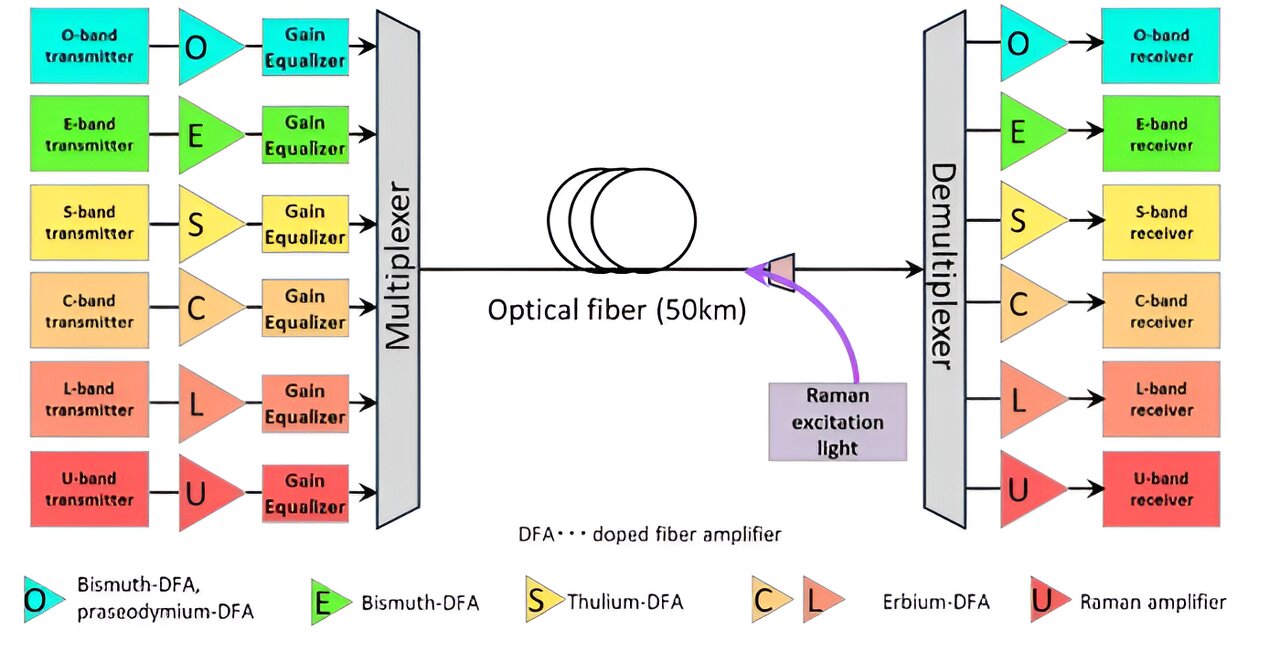An international research team led by Japan’s National Institute of Information and Communications Technology (NICT) has achieved a record in optical fiber communication. They have successfully demonstrated a record-breaking aggregate optical transmission bandwidth of 37.6 THz, resulting in a data transfer rate of 402 terabits per second (Tb/s) using standard commercially available optical fiber.

Also Read: OnePlus has Officially Announced OnePlus Ace 3 Pro
The team constructed an optical transmission system that utilizes all the major transmission bands O, E, S, C, L, and U within the low-loss window of standard optical fibers.
This system combined various advanced amplification technologies some of which were developed specifically for this experiment.
The system incorporated six types of doped fiber optical amplifiers including thulium (T-) doped fiber amplifiers, semiconductor optical amplifiers (SOAs) and both discrete and distributed Raman amplification.
These amplifiers enabled the use of new wavelength bands, greatly expanding the transmission capacity.
The experimental setup achieved dense wavelength division multiplexed (DWDM) transmission across a broad spectrum of 37.6 THz (275 nm) from 1,281.2 nm to 1,649.9 nm, covering all the major transmission bands.
This bandwidth facilitated the parallel transmission of over 1,500 channels boosting the data rate.
High data rates were realized using dual polarization (DP-) quadrature amplitude modulation (QAM), with up to 256 symbols per constellation. This advanced modulation technique allowed for efficient use of the wide bandwidth.
Novel optical gain equalizers were developed to enable uniform gain across the wideband spectrum allowing access to new wavelength bands that are not yet utilized in deployed systems.
Led by NICT’s Photonic Network Laboratory, the research involved collaboration with international partners including the Aston Institute of Photonic Technologies and Nokia Bell Labs. This joint effort was crucial in developing and testing the new transmission system.
The optical transmission system was designed to cover all transmission bands in the low-loss window of standard optical fibers.
This approach maximized the usable bandwidth and enabled the system to achieve the highest data rate recorded to date.
The system utilized six different types of doped fiber optical amplifiers each tailored to specific wavelength bands.
These included, Thulium (T-) doped fiber amplifiers for the C-band and C+L-band. Semiconductor optical amplifiers (SOAs). Discrete and distributed Raman amplification for signal strength across a wide range of wavelengths.
The system transmitted a wideband DWDM signal with 1,505 channels across a spectrum of 37.6 THz. This wide coverage allowed for an increase in data transfer rates.
Dual polarization (DP-) quadrature amplitude modulation (QAM) with up to 256 symbols per constellation was employed. This technique is for maximizing data throughput over the wideband spectrum.
To ensure uniform signal strength across the wideband spectrum, novel optical gain equalizers were developed. These equalizers allowed access to new wavelength bands and ensured that the signals remained balanced and strong throughout the transmission.
Also Read: Huawei Unveils HarmonyOS NEXT Without Android Apps
The 402 Tb/s data rate surpasses the previous highest single-mode fiber (SMF) data rate by over 25%. The aggregate transmission bandwidth of 37.6 THz represents a 35% increase compared to prior records.
The NICT researchers achieved a record-breaking data transmission speed of 402 Tbps. This feat was accomplished using commercially available standard optical fiber.
The new speed is roughly 5 million times faster than the average UK broadband speed of 69.4 Mbps in 2023 and 1.6 million times faster than the average US broadband speed of 248.27 Mbps as of May 2024.
At this speed, it would be possible to download 12,500 films in a single second, which is more than three times the number of movies currently available on Netflix.
The team utilized an approach covering all transmission bands of standard optical fibers. Various amplification technologies were employed including doped fiber amplifiers and distributed Raman amplification to optimize data transmission.
They tapped into previously unused wavelength regions greatly expanding the potential data transmission capacity of existing fiber optic cables.
Current fiber optic networks typically use a small slice of the available spectrum. The NICT team expanded this to cover a 37 THz of bandwidth over 1,505 transmission channels.
By accessing the full “Goldilocks zone” of frequencies where signals can travel long distances with minimal loss, the researchers maximized data throughput.
The team employed six different signal amplification methods ensuring data transmission across long distances. These devices enabled access to new wavelength bands.
As of 2023, the average broadband speed in the UK was 69.4 Mbps. The fastest speed available was 1.13 Gbps, which is still 400,000 times slower than the new record set by NICT.
In the US, the average broadband speed as of May 2024 was 248.27 Mbps. Cox recorded the fastest average speed among leading providers in the last quarter of 2023.
The results of this experiment were presented at the 47th International Conference on Optical Fiber Communications (OFC 2024) in San Diego. The paper detailing the findings was selected as a post-deadline paper.
Also Read: Synthesia 2.0 Introduces Full-Body AI Avatars for Communication





